COPERNICUS, Nicolaus (1473-1543). De revolutionibus orbium coelestium, libri VI. Nuremberg: Johann Petreius, 1543.
COPERNICUS, Nicolaus (1473-1543). De revolutionibus orbium coelestium, libri VI. Nuremberg: Johann Petreius, 1543. Small 2 o (260 x 190 mm). Collation : \Kp\k 6 a-z 4 A-Z 4 Aa-Cc 4. 196 leaves (of 202 lacking: title \Kp\k, \Kp\k6, a1, h4, k3, colophon Cc4). Numerous woodcut diagrams, tables of calculations, ornamental woodcut initials in part attributed to Hans Sebald Beham some Greek. (Lacking six leaves, \Kp\k2 with repair to blank margin, some light staining at beginning.) The above 6 missing leaves supplied in photostat facsimile from the Buffalo Public Library copy. Modern half vellum and boards. Provenance : 16th-century marginal study notes in Latin and Greek and a few calculations and underlinings; a few 18th and 19th-century marginal notes in Latin and Polish; Kosciusko Foundation, New York City, sold in the 1980's to a private collector, who donated the work to; The Copernicus Foundation, Chicago (sale, Susanin's, Chicago, May 11-12, 1996); the present owner (Christie's New York, 10 December 1999, lot 22). FIRST EDITION OF THE MOST IMPORTANT SCIENTIFIC PUBLICATION OF THE 16TH CENTURY AND A "LANDMARK IN HUMAN THOUGHT" ( PMM ). De revolutionibus placed for the first time the sun at the centre of the universe and described the earth's diurnal rotation and its annual rotation around the sun. Copernicus denounced the geocentric belief in the immobility of the earth as based on mere appearance. In order even to entertain an idea such as a heliocentric universe Copernicus had to break with virtually all current knowledge: astronomical, metaphysical, theological and, most basically, simple sensory perception. The geocentric system of Ptolemy had held sway for over a millennium; Aristotelianism dictated that there was a fundamental difference between heavenly and terrestial bodies; and theological dogma considered geocentrism as the very foundation of the special relationship between God and man. Aware of the radical nature of his theory, Copernicus composed an introduction in which he attempted to trace historical antecedents for his basic tenets. The Church never officially condemned Copernicus's work as heretical, in part because its observations were essential to reform of the calendar and thus to the precise determination of Easter. Copernicus first made known his ideas on heliocentrism in manuscript form only, which he circulated among a few colleagues. His radical work came to the attention of a young mathematician and astronomer, Georg Joachim Rheticus, who became the chief advocate of Copernicus's new theory. Rheticus persuaded Copernicus to publish his work in full, and delivered the manuscript of De revolutionibus to Johann Petreius at Nuremberg. Christie's thanks Professor Gingerich for supplying information regarding the provenance of this copy and the source of its facsimile leaves in An annotated census of Copernicus' 'De revolutionibus' (Nuremberg, 1543, and Basel, 1566). Adams C-2602; Dibner Heralds of Science 3; Horblit 18b; Houzeau and Lancaster 2503; PMM 70; Stillwell Awakening 47.
COPERNICUS, Nicolaus (1473-1543). De revolutionibus orbium coelestium, libri VI. Nuremberg: Johann Petreius, 1543.
COPERNICUS, Nicolaus (1473-1543). De revolutionibus orbium coelestium, libri VI. Nuremberg: Johann Petreius, 1543. Small 2 o (260 x 190 mm). Collation : \Kp\k 6 a-z 4 A-Z 4 Aa-Cc 4. 196 leaves (of 202 lacking: title \Kp\k, \Kp\k6, a1, h4, k3, colophon Cc4). Numerous woodcut diagrams, tables of calculations, ornamental woodcut initials in part attributed to Hans Sebald Beham some Greek. (Lacking six leaves, \Kp\k2 with repair to blank margin, some light staining at beginning.) The above 6 missing leaves supplied in photostat facsimile from the Buffalo Public Library copy. Modern half vellum and boards. Provenance : 16th-century marginal study notes in Latin and Greek and a few calculations and underlinings; a few 18th and 19th-century marginal notes in Latin and Polish; Kosciusko Foundation, New York City, sold in the 1980's to a private collector, who donated the work to; The Copernicus Foundation, Chicago (sale, Susanin's, Chicago, May 11-12, 1996); the present owner (Christie's New York, 10 December 1999, lot 22). FIRST EDITION OF THE MOST IMPORTANT SCIENTIFIC PUBLICATION OF THE 16TH CENTURY AND A "LANDMARK IN HUMAN THOUGHT" ( PMM ). De revolutionibus placed for the first time the sun at the centre of the universe and described the earth's diurnal rotation and its annual rotation around the sun. Copernicus denounced the geocentric belief in the immobility of the earth as based on mere appearance. In order even to entertain an idea such as a heliocentric universe Copernicus had to break with virtually all current knowledge: astronomical, metaphysical, theological and, most basically, simple sensory perception. The geocentric system of Ptolemy had held sway for over a millennium; Aristotelianism dictated that there was a fundamental difference between heavenly and terrestial bodies; and theological dogma considered geocentrism as the very foundation of the special relationship between God and man. Aware of the radical nature of his theory, Copernicus composed an introduction in which he attempted to trace historical antecedents for his basic tenets. The Church never officially condemned Copernicus's work as heretical, in part because its observations were essential to reform of the calendar and thus to the precise determination of Easter. Copernicus first made known his ideas on heliocentrism in manuscript form only, which he circulated among a few colleagues. His radical work came to the attention of a young mathematician and astronomer, Georg Joachim Rheticus, who became the chief advocate of Copernicus's new theory. Rheticus persuaded Copernicus to publish his work in full, and delivered the manuscript of De revolutionibus to Johann Petreius at Nuremberg. Christie's thanks Professor Gingerich for supplying information regarding the provenance of this copy and the source of its facsimile leaves in An annotated census of Copernicus' 'De revolutionibus' (Nuremberg, 1543, and Basel, 1566). Adams C-2602; Dibner Heralds of Science 3; Horblit 18b; Houzeau and Lancaster 2503; PMM 70; Stillwell Awakening 47.




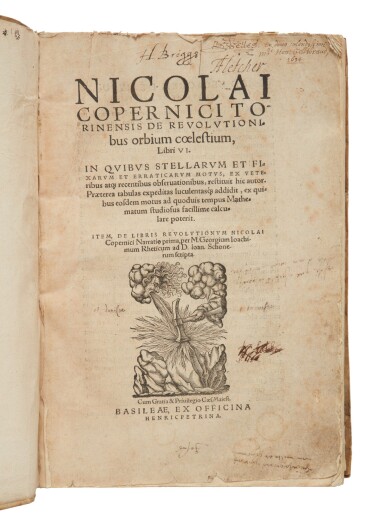
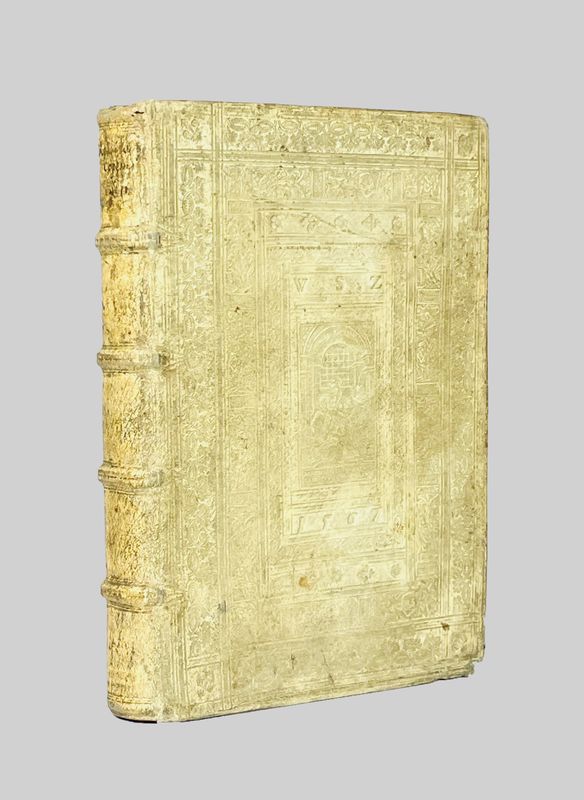
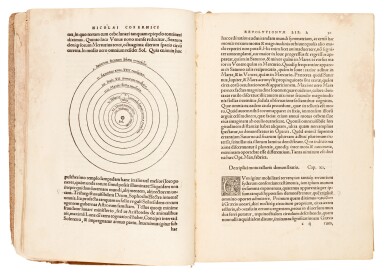


.jpg)

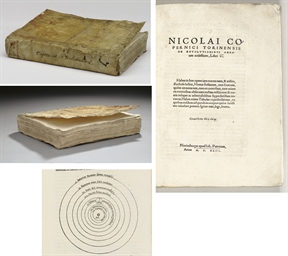
.jpg)
.jpg)
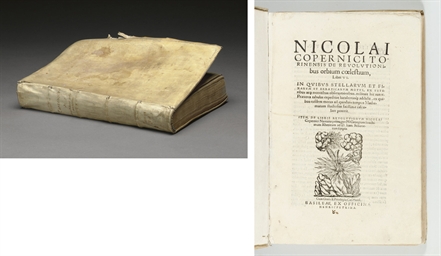
Testen Sie LotSearch und seine Premium-Features 7 Tage - ohne Kosten!
Lassen Sie sich automatisch über neue Objekte in kommenden Auktionen benachrichtigen.
Suchauftrag anlegen